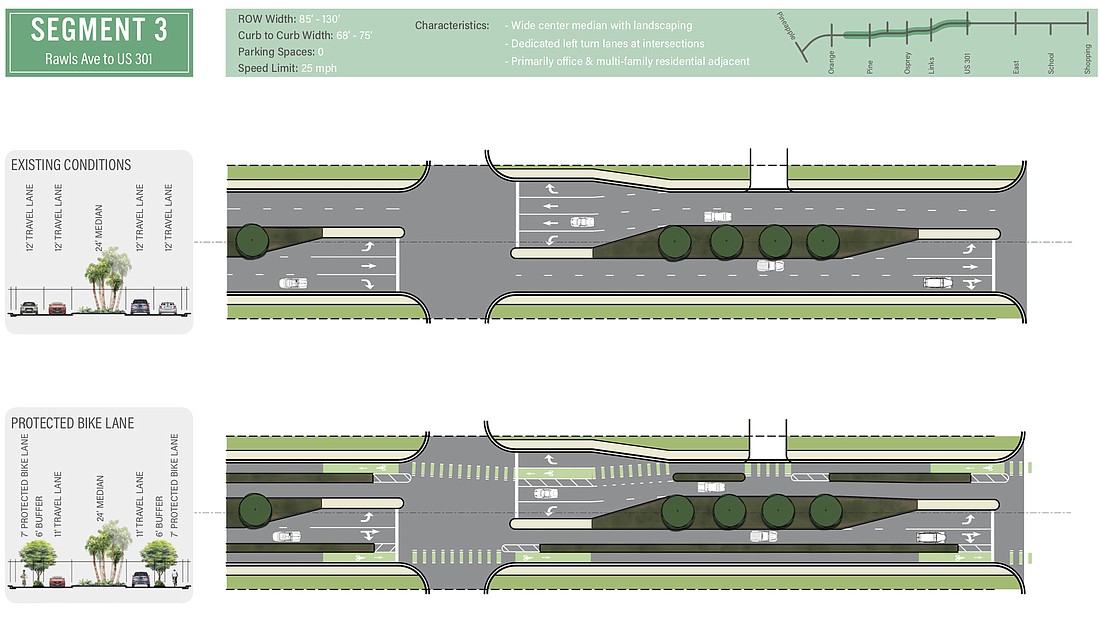- April 25, 2024
-
-
Loading

Loading

The City Commission unanimously endorsed a proposal to redesign a segment of Ringling Boulevard to add bike lanes, a project that could transform an entryway to downtown Sarasota before the end of 2021.
City staff has been working for about a year on plans for the Ringling Trail, a project covering a one-mile stretch of roadway from Lime Avenue to Pineapple Avenue. The city intends to create protected bike lanes on the street and add landscaping. In the process, Ringling Boulevard would shrink from four to two vehicle travel lanes for the majority of the project area.
At Monday’s commission meeting, planning and engineering staff said Ringling was a good fit for a bike-centric project because of its proximity to the planned Legacy Trail extension in Payne Park. City officials said motor vehicle traffic on Ringling Boulevard is relatively limited compared to larger streets such as Fruitville Road. Staff shared projections stating the vehicular capacity on the street should still be adequate through 2040 even with the lane reductions.
Commissioners offered strong support for the plan, calling it an opportunity to improve biking infrastructure while allowing residents, businesses and visitors to capitalize on access to the Legacy Trail.
“We need to provide different modes of transportation to help us become more sustainable,” Commissioner Kyle Battie said.
After the commission voted to adopt the concept plan, the city will now develop more detailed design documents for the Ringling Trail. City staff indicated they intend to pursue the buildout of the project in two phases. First, a short-term project focused on restriping and plastic bollards to create the protected bike lanes. The city estimated phase one could be built by this fall at a projected cost of $900,000.
The second phase would involve more intensive construction to permanently redesign the road, adding the landscaping and physical barriers included in the concept plan. Assistant City Engineer Dan Ohrenstein said the full buildout could cost $10 million and take five to 10 years as the city seeks funding. When commissioners asked whether the city should hold off on any changes until phase two is ready, Ohrenstein said staff wanted to have improvements in place in time for the expected completion of the Legacy Trail extension in early 2022.
Although three speakers at Monday’s meeting were opposed to the project, staff said a majority of the public feedback associated with the proposal was positive. Groups such as the Downtown Sarasota Condominium Association and the Downtown Improvement District submitted letters of support to the city. Ohrenstein said the city worked to contact business owners and resident associations near the trail route as part of an outreach effort last year.
An online survey on the proposal gathered 700 responses, 95% of which supported redesigning Ringling to better accommodate bikes.
“I would challenge anyone to find an issue in society today that has that much positivity,” Ohrenstein said.
Commissioner Erik Arroyo said he had heard a similar sentiment from residents in District 3.
“I have spoken with people from my district, and they would like access to the Legacy Trail and to downtown from the neighborhoods, especially in a time when people really are struggling to purchase cars and to purchase homes,” Arroyo said. “They would like a relatively low-cost way of transportation that is safe.”
Dan Lobeck, a downtown resident who has objected to the city’s efforts to promote alternate modes of transportation by adjusting roadway design, expressed concern that reducing the number of travel lanes would negatively affect traffic. Ohrenstein said projections indicated traffic congestion would likely worsen on Ringling after the project is built out, but staff was confident it would remain an acceptable level of service for an urban street.
Arroyo noted studies from other cities showed road narrowing was often not detrimental to traffic while creating other benefits, such as increased business activity and improved safety.
“The argument shouldn’t be bikes versus cars,” Arroyo said. “It should be choice. We’re expanding choice from unimodal to multimodal. We’re incentivizing economic development. We are providing connectivity.”